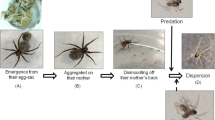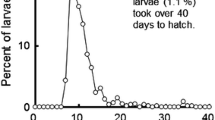Summary
-
1.
The amount of food intake during the egg ripening period and the conversion of this food into eggs (biomass and number of eggs) in four Pardosa species is described.
The amount of food taken in is dependent on the size of the spider species.
Basically the process of conversion of food into egg-biomass is the same for all four species. Thus the size of the spider species mainly determines the number of eggs in the egg-sac. There are however minor differences in “efficiency” of the process and in dryweight of the eggs between the species. These differences which are discussed complicated the general process of food conversion into number of eggs.
-
2.
When food shortages are supplied during the egg ripening period two reactions can be observed:
-
a)
All species tend to keep the dry weight of the eggs at a constant level.
-
b)
Some species produce the same number of eggs under conditions of small food shortages as under conditions of maximum food supply, using reserve material from the body of the female. In this case the female either shows no increase in body weight or a decrease while others immediately adapt the number of eggs to the quantity of food given.
-
a)
Under conditions of strong food shortages, however, both groups of species show the same reaction.
Similar content being viewed by others
References
Edgar, W. D.: Aspects of the ecology of the wolf spider Lycosa lugubris (Walckenaer). Thesis University of Glasgow (1968).
—: The life-cycle, abundance and seasonal movement of the wolf spider, Lycosa (Pardosa) lugubris in Central Scotland. J. Anim. Ecol. 40, 303–321 (1971).
—: Seasonal weight changes, age structure, natality and mortality in the wolf spider Pardosa lugubris Walck. in Central Scotland. Oikos 22, 84–92 (1971).
Haynes, D. L., Sisojevic, P.: Predatory behaviour of Philodromus rufus Walckenaer (Araneae: Thomisidae). Can. Ent. 98, 113–133 (1966).
Kessler, A.: Egg production in Pardosa. 1. Influence of mating on the egg-ripening period in Pardosa lugubris (Walckenaer) (Araneae, Lycosidae). Bull. Mus. nat. Hist. Paris 41, 98–101 (1969).
Miyashita, K.: Quantitative feeding biology of Lycosa T-insignita Boes. et Str. (Araneae: Lycosidae). Bull. Nat. Inst. Agr. Sc. (Japan) 22, 329–344 (1968).
Parry, D. A.: Spider hydraulics. Endeavour 19, 156–162 (1960).
Petersen, B.: The relation between size of mother and number of eggs and young in some spiders and its significance for the evolution of size. Experientia (Basel) 6, 96–98 (1950).
Turnbull, A. L.: Quantitative studies of the food of Linyphia triangularis Clerck (Aranea: Linyphiidae). Can. Ent. 94, 1233–1249 (1962).
—: Effects of prey abundance on the development of the spider Agelenopsis potteri (Blackwell) (Araneae: Agelenidae). Can. Ent. 97, 141–147 (1965).
Vlijm, L., Kessler, A., Richter, C. J. J.: The life-history of Pardosa amentata (Cl.) Araneae, Lycosidae. Ent. Ber. (Amst.) 23, 75–80 (1963).
—, Richter, C. J. J.: Activity fluctuations of Pardosa lugubris (Walck.) Araneae, Lycosidae, during the breeding season. Ent. Ber. (Amst.) 26, 222–230 (1966).
Author information
Authors and Affiliations
Rights and permissions
About this article
Cite this article
Kessler, A. Relation between egg production and food consumption in species of the genus Pardosa (Lycosidae, Araneae) under experimental conditions of food-abundance and food-shortage. Oecologia 8, 93–109 (1971). https://doi.org/10.1007/BF00345629
Received:
Issue Date:
DOI: https://doi.org/10.1007/BF00345629




